- A multicenter study is a study that was conducted in a large number of specialized clinical centers.
- Randomized - a study in which patients are distributed into groups randomly.
- Double blind placbo-controlled-a study in which neither a research doctor nor the patient know what the patient receives: the study drug or placebo.
The MEGA Study
of Attention Deficit Hyperactivity Disorder
in Children
The drug Mexidol® showed a high degree of effectiveness and safety
in the treatment of attention deficiency and hyperactivity disorder (ADHD) in children
during a multicenter-centered double-centered
placebo-controlled clinical study (1].

The effectiveness of the therapy scheme with Mexidol®
with ADHD is proved - 1 tablet 125 mg 2 times a day for 1.5 months.
Repeated courses can be recommended after 2-3 months [2].
dosing modes of the drug Mexidol® tablets covered with a film
membrane, 125 mg (LLC NPK “Pharmasoft”, Russia), compared with placebo
in children with ADH agents from 6 to 12 years.
- A multicenter study is a study that was conducted in a large number of specialized clinical centers.
- Randomized - a study in which patients are distributed into groups randomly.
- Double blind placbo-controlled-a study in which neither a research doctor nor the patient know what the patient receives: the study drug or placebo.
Research design
The study of Mega was conducted in three parallel groups, 333 children aged 6 to 12 years with a confirmed diagnosis of ADHD, established in accordance with the CCB-10 and DSM-5 criteria, were attended by all patients were at 333.
- Patients of the 1st group received Mexidol® 125 mg 2 times a day;
- Patients of the 2nd group received Mexidol® 125 mg once a day + placebo;
- Patients of the 3rd group received only placebo.
The duration of treatment in all groups was 42 days (Fig. 1).
Mega research design
14 clinical centers
Multicenter, double blind, randomized, placebo-controlled in three parallel groups, a clinical study on evaluating the effectiveness and safety of the drug Mexidol® in the treatment of attention deficit syndrome (ADHD) in children (mega)
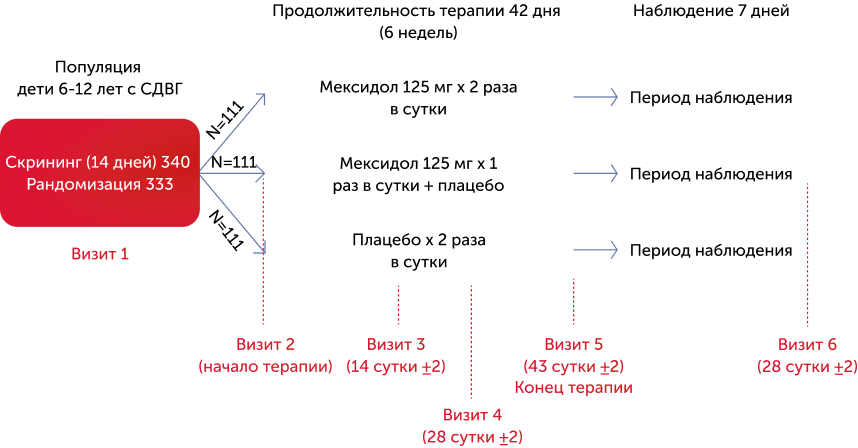
Figure 1. Research Design Mega

Efficiency criteria
As the primary criterion of effectiveness, the average change in the sum of the total score for the subx “Inattention”, “Hyperactivity/impulsiveness” of the Snap-IV scale (a questionnaire consisting of 43 issues that allows us to evaluate the degree of impaired attention, hyperactivity and impulsiveness) after 6 weeks of therapy) Compared to the initial level [3].
The secondary criteria for effectiveness attributed average changes after 6 weeks of therapy compared to the initial level:
- on Snap-IV Snap-IV "Inattention",
- According to Snap-IV “Hyperactivity/impulsiveness” SNAP-IV,
- According to Snap-IV subsh on the opposition-calling disorder of behavior,
- Converses index (determines the rating of an external observer and self -report to assess the deficiency of attention and hyperactivity),
- a general assessment of the symptoms of ADHD on the ADHD Rating Scale-IV scale (a questionnaire consisting of 18 SDVG criteria),
- Assessments on the scale of the general clinical impression of the severity of ADHD (CGI-DHD-S) [4],
- Assessments on the scale of the general clinical impression- improvement (CGI-I) [5],
- General assessment on the children's anxiety scale (SCAS) [6].
Results
When analyzing the results of the primary criterion of the effectiveness, it was found that at the end of 6 weeks of therapy, statistically significant changes in the amount of the total score on the subx “Inattention”, “Hyperactivity/impulsiveness” of the SNAP-IV scale were obtained. The most pronounced dynamics was observed in the Mexidol® 125 mg 25 mg group (-29% of the initial level). There were statistically significant differences between all groups (Fig. 2).
Changing in % of the values of the average change in the sum of the total score for subx “Inattention”, “Hyperactivity/impulsiveness” Snap-IV after 6 weeks of therapy
The primary criterion of effectiveness

Statistically significant changes in assessments on the subx “Inattention”, “hyperactivity/impulsiveness” of SNAP-IV after 6 weeks of therapy were detected in all three groups of patients. (p <0.000001)
In the Mexidol® 125 mg group 29% of the main manifestations of ADHD, 29%
Figure 2. The results of the primary criterion of efficiency are the dynamics of changing the sum of the total score for the subx “Inattention”, “Hyperactivity/impulsiveness” of the Snap-Iv scale after 6 weeks of therapy.
Based on the results of the assessment of secondary criteria for effectiveness at the end of 6 weeks of therapy, statistically significant differences in the average change in scores on “Inattention” (-26 %), “Hyperactivity/impulsiveness” (-33 %), according to the Conance Index (-33 %) were obtained SNAP-IV scales (Fig. 3), average change in the ADHD Rating Scale IV (-30 %) scale (Fig. 4), CGI-DHD-S ratings (52 % of patients with ADHG passed into a light course), CGI-I scores (improvement or significant improvement were noted in 52 % of patients) (Fig. 5).
Changing in % median scores on the submarine “Inattention”, SNAP-IV after 6 weeks of therapy
Secondary effectiveness criterion
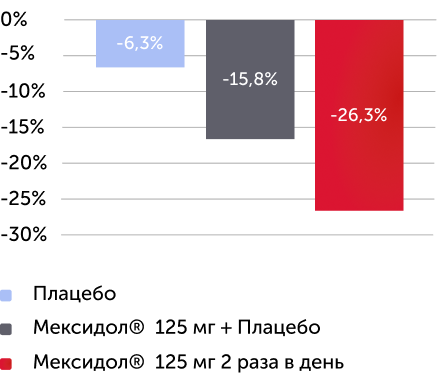
The differences between the groups on the subshkal “Inattention” are statistically significant (p <0,0001)
In the Mexidol® 125 mg group, more than 26% regression on Subshkala “Inattention” was celebrated 26%
Changing in % median scores for subsh on, Snap -IV - “hyperactivity/impulsivity” after 6 weeks of therapy
Secondary effectiveness criterion
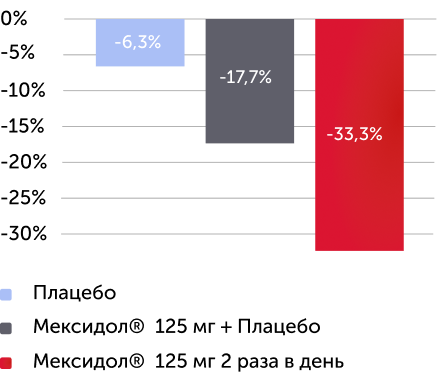
The differences between the groups on the subshkal “hyperactivity/impulsiveness” are statistically significant (p <0,0001)
In the Mexidol® 125 mg group 2 times a day, more than 30% of the regression on subshkal “Hyperactivity/impulsiveness” was noted
The average change in the score on Snap -IV subshkal is the Connsers index after 6 weeks of therapy
Secondary effectiveness criterion
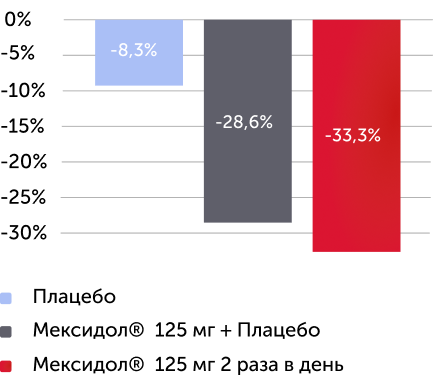
The differences between the groups on the Conance index are statistically significant (p <0.0001)
In the Mexidol® 125 mg group 2 times a day, more than 30% of the regress on the Conners index was noted
Figure 3. Change in the average score for subx “Inattention”, “Hyperactivity/impulsiveness” and on the Conance index after 6 weeks of therapy
the ADHD Rating Scale - IV) symptoms scale
Secondary effectiveness criterion
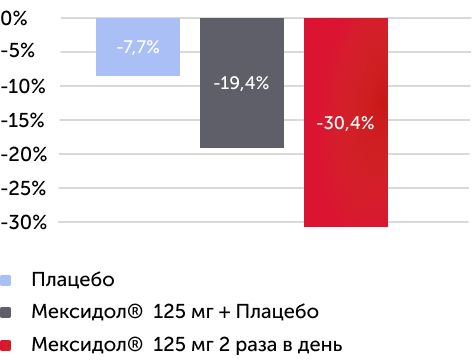
The differences between the groups on the ADHD RS-IV scale are statistically significant (p <0,0001)
In the Mexidol group, 125 mg 2 times a day, more than 30% regression was marked on the ADHD scale
Figure 4. Changes in the average score on the ADHD Rating Scale IV scale after 6 weeks of therapy
CGI-I scale
The overall clinical impression scale is the improvement of The Clinical Global Impression Scale - Improviment
Secondary effectiveness criterion
Changes in the average score on the ADHD Rating Scale IV scale after 6 weeks of therapy
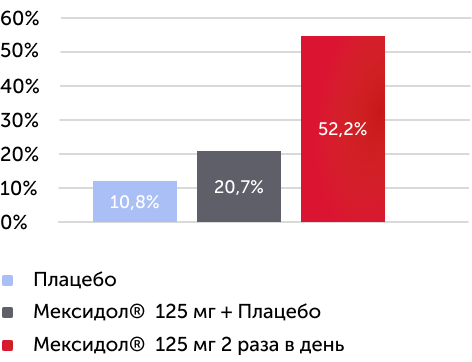
At the end of therapy between the groups, statistically significant differences were revealed on the scale of the general clinical impression - improvement (p <0.0001)
On the CGI-I scale in the Mexidol® group 125 mg 2 times a day more than half of the patients, an improvement or a significant improvement was noted
Figure 5. Dynamics of changes on the CGI-I scale after 6 weeks of therapy
Safety
The results of a statistical analysis of the frequency of the occurrence of undesirable phenomena, indicators of laboratory tests and physical examination demonstrated the absence of significant differences between the compared groups by the main safety indicators. Thus, the comparable nature of the security profiles of the studied dosing of the drug Mexidol® and placebo is proven.
Conclusions
The study showed that the drug Mexidol® has high efficiency in the treatment of ADHD in children from 6 to 12 years and safety comparable to placebo. When evaluating the main and most secondary criteria for the effectiveness of the treatment regimen Mexidol® tablets covered with a film shell, 125 mg 2 times a day showed its advantage over the Mexidol® scheme covered with a film shell 1 time per day.
List of literature
- Zavadenko N.N., Suvorinova N.Yu., Batysheva T.T. et al. The results of a multicenter double blind randomized placebo -controlled clinical study on the assessment of the effectiveness and safety of the drug Mexidol in the treatment of attention deficit syndrome in children (mega). Journal of neurology and psychiatry named after S.S. Korsakova. 2022; 122 (4): 75–86.
- Zavadenko N.N., Suvorinova N.Yu., Zavadenko A.N. The possibilities of using Mexidol in neuropediatrics. Journal of neurology and psychiatry named after S.S. Korsakova. 2023; 123 (9 outp. 2): 43–50.
- Swanson JM, Schuck S, Porter MM, et al. Categorical and Dimensional Definitions and Evaluations of Symptoms of AdHD: History of the Snap and the Swan Rating Scales. Int J EDUC PSYCHOL ASSESS. 2012; 10: 51-70.
- Busner J, Targum SD. The Clinical Global Impressions Scale. Psychiatry Edgmont. 2007; 4: 28-37.
- SPENCE SH, Barrett PM, Turner CM. PSYCHOMETRIC Properties of the Spade Children's Anxiety Scale with Young Adolescents. J Anxiety Disord. 2003; 17: 605-625.
- Orgilés M, Fernández-Martínez I, Guillén-Ruquelme a, Espada JP, Essau Ca. A Systematic Review of the Factor Structure and Reliability of the Spence Children's Anxiety Scale. J Affect Disord. 2016; 190: 333-340.
THE INFORMATION IS INTENDED FOR HEALTHCARE AND PHARMACEUTICAL PROFESSIONALS. THIS INFORMATION IS NOT INTENDED AS A SUBSTITUTE FOR MEDICAL ADVICE.
Source of photos and images Shutterstock.com